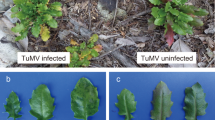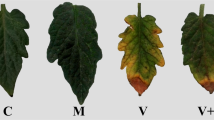Abstract
Salicylic acid (SA), produced by plants as a signal in defense against pathogens, induces metabolic heating mediated by alternative respiration in flowers of thermogenic plants, and, when exogenously applied, increases leaf temperature in nonthermogenic plants. We have postulated that the latter phenomenon would be detectable when SA is synthesized locally in plant leaves. Here, resistance to tobacco mosaic virus (TMV) was monitored thermographically before any disease symptoms became visible on tobacco leaves. Spots of elevated temperature that were confined to the place of infection increased in intensity from 8 h before the onset of visible cell death, and remained detectable as a halo around the ongoing necrosis. Salicylic acid accumulates during the prenecrotic phase in TMV-infected tobacco and is known to induce stomatal closure in certain species. We show that the time course of SA accumulation correlates with the evolution of both localized thermal effect and stomatal closure. Since the contribution of leaf respiration is marginal, we concluded that the thermal effect results predominantly from localized, SA-induced stomatal closure. The presymptomatic temperature increase could be of general significance in incompatible plant–pathogen interactions.
This is a preview of subscription content, access via your institution
Access options
Subscribe to this journal
Receive 12 print issues and online access
$209.00 per year
only $17.42 per issue
Buy this article
- Purchase on Springer Link
- Instant access to full article PDF
Prices may be subject to local taxes which are calculated during checkout






Similar content being viewed by others
References
Malamy, J., Carr, J.P., Klessig, D.F. & Raskin, I. Salicylic acid: a likely endogenous signal in the resistance response of tobacco to viral infection. Science 250,1002– 1004 (1990).
Métraux, J.P. et al. Increase in salicylic acid at the onset of systemic acquired resistance in cucumber. Science 250, 1004– 1006 (1990).
Uknes, S. et al. Regulation of pathogenesis-related protein-1a gene expression in tobacco. Plant Cell 5, 159–169 (1993).
Raskin, I., Turner, I.M. & Melander, W.R. Regulation of heat production in the inflorescences of an Arum lily by endogenous salicylic acid. Proc. Natl. Acad. Sci. USA 86, 2214–2218 ( 1989).
Larqué-Saavedra, A. Stomatal closure in response to acetylsalicylic acid treatment. Z. Pflanzenphysiol. 93, 371–375 (1979).
Manthe, B., Schulz, M. & Schnabl, H. Effects of salicylic acid on growth and stomatal movements of Vicia faba L.: evidence for salicylic acid metabolization. J. Chem. Ecol. 18, 1525–1539 (1992).
Van Der Straeten, D., Chaerle, L., Sharkov, G., Lambers, H., & Van Montagu, M. Salicylic acid enhances the activity of the alternative pathway of respiration in tobacco leaves and induces thermogenicity. Planta 196, 412–419 ( 1995).
Malamy, J., Hennig, J. & Klessig, D.F. Temperature-dependent induction of salicylic acid and its conjugates during the resistance response to tobacco mosaic virus infection. Plant Cell 4, 359– 366 (1992).
Mur, L.A.J., Bi, Y.-M., Darby, R.M., Firek, S. & Draper, J. Compromising early salicylic acid accumulation delays the hypersensitive response and increases viral dispersal during lesion establishment in TMV-infected tobacco. Plant J. 12, 1113 –1126 (1997).
Enyedi, A.J., Yalpani, N., Silverman, P. & Raskin, I. Localization, conjugation, and function of salicylic acid in tobacco during the hypersensitive reaction to tobacco mosaic virus. Proc. Natl. Acad. Sci. USA 89, 2480–2484 (1992).
De Carolis, C., Conti, G.G. & Lechi, G.M. In Proceedings of the 10th International Symposium on Remote Sensing and Environment. 659–672 (Environmental Research Institute of Michigan, Ann Arbor, MI; 1975).
Yalpani, N., Silverman, P., Wilson, T.M.A., Kleier, D.A. & Raskin, I. Salicylic acid is a systemic signal and an inducer of pathogenesis-related proteins in virus-infected tobacco. Plant Cell 3, 809–818 (1991).
Friedrich, L., Vernooij, B., Gaffney, T., Morse, A. & Ryals, J. Characterization of tobacco plants expressing a bacterial salicylate hydroxylase gene. Plant Mol. Biol. 29:, 959–968 ( 1995).
Gaffney, T. et al. Requirement of salicylic acid for the induction of systemic acquired resistance. Science 261, 754– 756 (1993).
Lennon, A.M., Neuenschwander, U.H., Ribas-Carbo, M., Giles, L., Ryals, J.A., & Siedow, J.N. The effects of salicylic acid and tobacco mosaic virus infection on the alternative oxidase of tobacco. Plant Physiol. 115, 783–791 ( 1997).
Chivasa, S., Murphy, A.M., Naylor, M. & Carr, J.P. Salicylic acid interferes with tobacco mosaic virus replication via a novel salicylhydroxamic acid–sensitive mechanism. Plant Cell 9, 547–557 (1997).
Chivasa, S. & Carr, J. Cyanide restores N gene-mediated resistance to tobacco mosaic virus in transgenic tobacco expressing salicylic acid hydroxylase. Plant Cell 10, 1489–1498 (1998).
Day, D.A. et al. The cyanide-resistant oxidase: to inhibit or not to inhibit, that is the question. Plant Physiol. 110, 1– 2 (1996).
McNulty, A.K. & Cummins, W.R. The relationship between respiration and temperature in leaves of the arctic plant Saxifraga cernua. Plant Cell Environ. 10, 319–325 (1987).
Breidenbach, R.W., Saxton, M.J., Hansen, L.D. & Criddle, R.S. Heat generation and dissipation in plants: can the alternative oxidative phosphorylation pathway serve a thermoregulatory role in plant tissues other than specialized organs? Plant Physiol. 114, 1137– 1140 (1997).
Leung, J. & Giraudat, J. Abscisic acid signal transduction. Annu. Rev. Plant Physiol. Plant Mol. Biol. 49, 199–222 (1998).
Raskin, I. & Ladyman, J.A.R. Isolation and characterization of a barley mutant with abscisic acid–insensitive stomata. Planta 173, 73–78 ( 1987).
Whenham, R.J. & Fraser, R.S.S. Effect of systemic and local-lesion-forming strains of tobacco mosaic virus on abscisic acid acid concentration in tobacco leaves: consequences for the control of leaf growth. Physiol. Plant Pathol. 18, 267–278 (1981).
Weyers, J.D.B. & Meidner, H. Methods in stomatal research. (Longman Scientific & Technical, Harlow, UK; 1990).
Nillsson, H.-E. Remote sensing and image analysis in plant pathology. Ann Rev. Phytopathol. 15, 489–527 (1995).
Bachem, C.W.B., van der Hoeven, R.S., de BruiJn, S.M., Vreugdenhil, D., Zabeau, M., & Visser, R.G.F. Visualization of differential gene expression using a novel method of RNA fingerprinting based on AFLP: analysis of gene expression during potato tuber development. Plant J. 9, 745–753 (1996).
Liang, P. & Pardee, A.B. 1997. Differential Display Methods and Protocols (Methods in Molecular Biology, Vol. 85) Humana Press, Totowa, NJ.
Bi. Y–M., Kenton, P., Mur, L., Darby, R. & Draper, J. Hydrogen peroxide does not function downstream of saliclic acid in the induction of PR protein expression. Plant J., 8, 235–245 (1995).
SAS/STAT Software. 1992. Changes and Enhancements, Release 6.07 (SAS Technical Report P-229), SAS Institute inc., Cary, NC.
Acknowledgements
We thank T.J. Pons and R. Welschen (Department of Plant Ecology and Evolutionary Biology, University of Utrecht, The Netherlands) for advice on energy-budget calculations and steady state porometry and for help with respiratory and steady state porometrical measurements, respectively; O. Thas (Biomath Department, University of Gent, Belgium) for the statistical analysis with SAS; R. Samson (Department of Applied Ecology and Environmental Biology, University of Gent) for advice on diffusion porometrical measurements; J. Ryals (Novartis, Research Triangle Park, NC, USA) for providing the tobacco line NahG-10; and M. De Cock for lay-out. This research was supported by grants from the Fund for Scientific Research (Flanders) (G.0023.95N and 1.5.514.98). L.C. was a Research Assistant and D.V.D.S. is a Research Associate of the Fund for Scientific Research (Flanders).
Author information
Authors and Affiliations
Corresponding author
Rights and permissions
About this article
Cite this article
Chaerle, L., Caeneghem, W., Messens, E. et al. Presymptomatic visualization of plant–virus interactions by thermography . Nat Biotechnol 17, 813–816 (1999). https://doi.org/10.1038/11765
Received:
Accepted:
Issue Date:
DOI: https://doi.org/10.1038/11765
This article is cited by
-
Sensor-based phenotyping of above-ground plant-pathogen interactions
Plant Methods (2022)
-
Nitrogen improves plant cooling capacity under increased environmental temperature
Plant and Soil (2022)
-
A parameter of thermographic difference used in sunny summer midday and its significance
Journal of Thermal Analysis and Calorimetry (2021)
-
Enhanced heat tolerance of viral-infected aphids leads to niche expansion and reduced interspecific competition
Nature Communications (2020)
-
What proteomics can reveal about plant–virus interactions? Photosynthesis-related proteins on the spotlight
Theoretical and Experimental Plant Physiology (2019)



